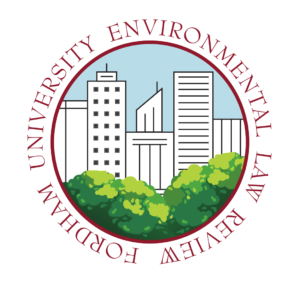Environmental Policy: NYC Congestion Pricing
Owen Topf
ELR Staffer FLS 26
New York City, one of the most congested cities in the world, has implemented a solution to combat traffic gridlock and reduce its environmental footprint, congestion pricing. Under this policy, drivers will be charged a fee to enter Manhattan’s central business district (60th Street and lower, but not counting FDR Drive and the West Side Highway). It aims to reduce traffic, improve air quality, and generate revenue for transit infrastructure. While the policy has been praised by some, it also has its share of advocates and detractors. Congestion pricing holds pros, cons, and challenges.
Pros
Reduction of air pollution
One of the most compelling arguments for congestion pricing is its potential to reduce air pollution. Traffic congestion is a major contributor to the city’s high levels of nitrogen oxide (NOx), particulate matter, and carbon dioxide (CO2) emissions, which can worsen public health and contribute to climate change. The policy aims to reduce tailpipe emissions by discouraging unnecessary car trips into Manhattan, ultimately decreasing the number of vehicles on the road. With fewer cars and trucks, the city’s air quality can improve, benefiting both the environment and public health, particularly in neighborhoods located near highways and major roads.
Encouragement of Sustainable Transportation
Congestion pricing could also accelerate the shift towards more sustainable modes of transportation. With a financial disincentive to drive, commuters may choose public transit, biking, or walking instead. This shift aligns with New York City’s broader sustainability goals, which include reducing greenhouse gas emissions and promoting cleaner transportation options. The additional revenue generated from congestion pricing will be earmarked for improving and expanding the city’s already extensive public transportation network, making it a more attractive option for New Yorkers.
Reduced Traffic Congestion
By implementing a pricing scheme that charges drivers to enter certain areas of the city, congestion pricing directly addresses one of New York’s most persistent problems—traffic jams. Fewer cars on the road not only lead to quicker commutes but also reduce the overall wear and tear on the city’s streets. This reduction in congestion can make public transit more reliable and efficient, attracting even more commuters to the system, further lowering the environmental impact.
Cons
Potential Displacement of Traffic
One potential downside of congestion pricing is traffic displacement to surrounding neighborhoods. As drivers seek to avoid the congestion fee, they may take alternative routes, potentially leading to increased traffic in previously less-congested areas. This could result in localized air pollution and noise in communities that were not part of the original congestion zone, creating environmental issues in new areas.
Disproportionate Impact on Low-Income Drivers
While congestion pricing is intended to target those who drive into the city for business or leisure, it could disproportionately affect lower-income residents who depend on cars for commuting (however, there are discounts and exemptions people can get. Many of these individuals live in outer boroughs with limited access to public transit options. For them, the cost of entering the congestion zone could be a financial burden, potentially exacerbating income inequality.
Equity Concerns
The environmental benefits of congestion pricing may not be equally shared across all communities. While wealthy residents and businesses may be able to afford the pricing, lower-income populations may struggle with the added cost. There is also a risk that these policies could disproportionately burden people who work essential jobs (like healthcare or retail) in the city’s core, who may not have viable transit alternatives.
Challenges
The federal government, particularly the Trump administration, has expressed concerns that New York City did not properly seek approval from the federal government before proceeding with the congestion pricing plan. The administration argued that since the project involves federal funds and transportation systems that cross state lines, it should have been subject to additional federal review. These concerns culminated in the revocation of approval by the Department of Transportation, which Trump officials say is needed for the policy to remain implemented.
In response, the MTA has filed a suit against the Secretary of Transportation claiming that the move to terminate congestion pricing is unlawful based on principles of the United States Constitution and the Administrative Procedure Act. In essence, those who are ordering the termination of congestion pricing are not authorized to act in that capacity.
Conclusion
Congestion pricing in New York City presents a bold and innovative solution to reduce traffic, improve air quality, and promote sustainable transportation. From an environmental perspective, its benefits are clear: lower emissions, less congestion, and more investment in public transit. However, the policy’s effectiveness will depend on how the city addresses the potential negative consequences, such as traffic displacement and equity concerns. Ensuring that the environmental gains are equitably distributed will be key to making congestion pricing successful in New York City.

